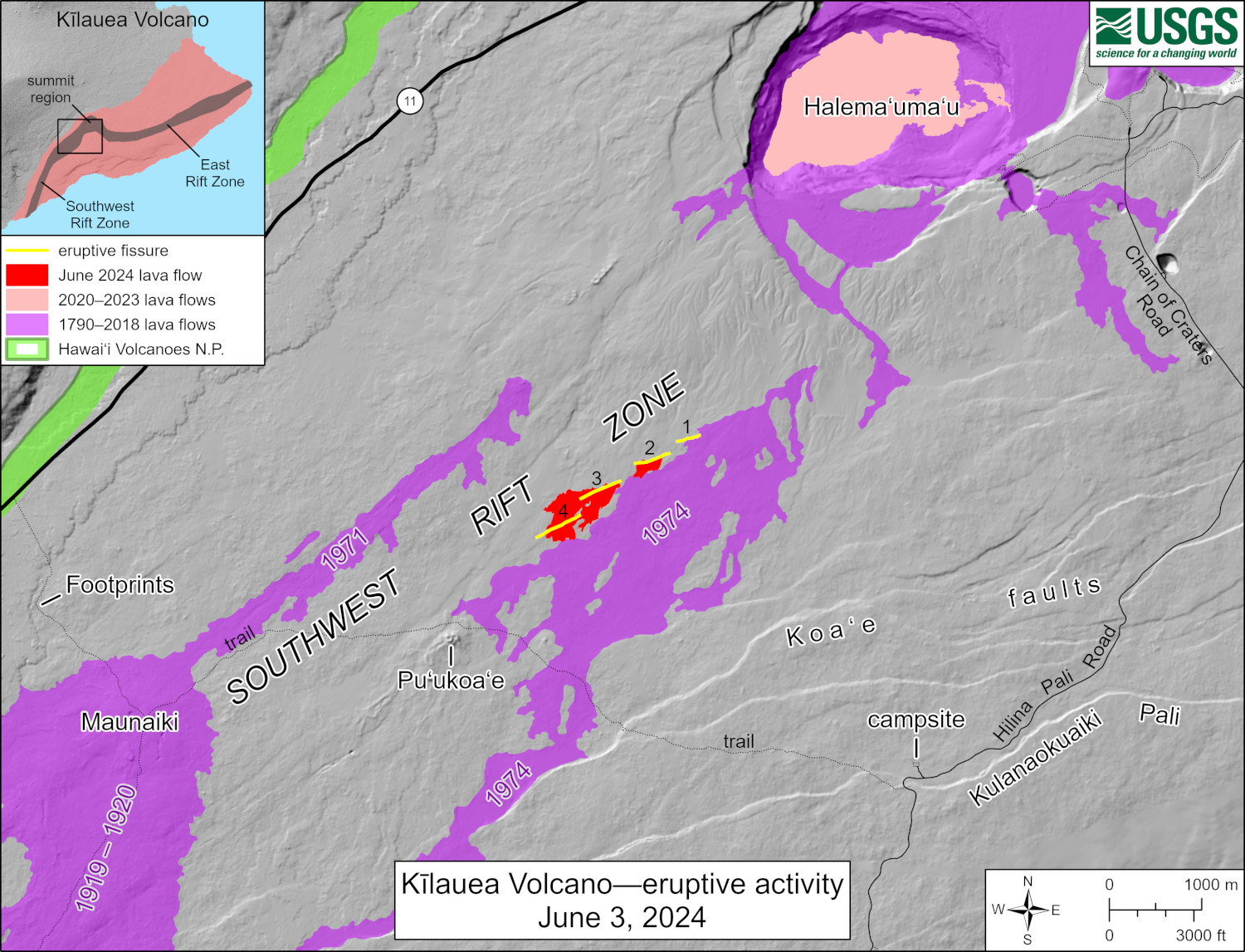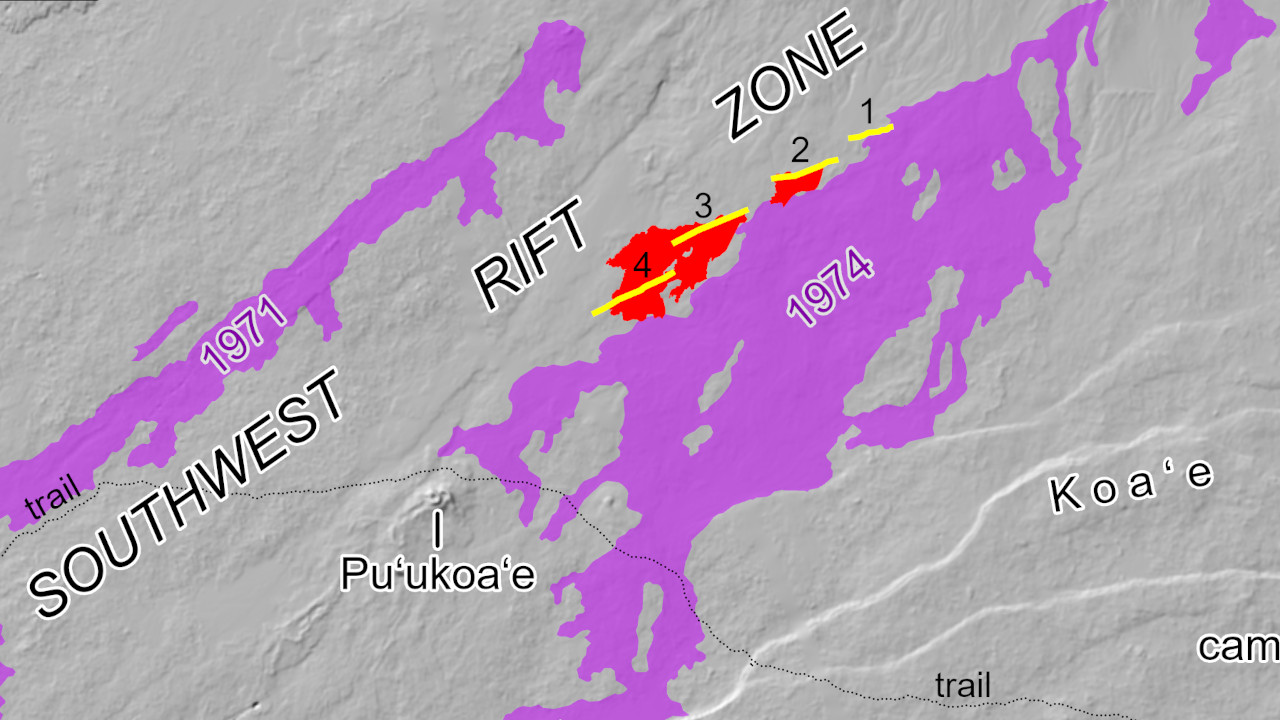New Kilauea Volcano Eruption Lasts Only 12 Hours (June 4, 2024)
(BIVN) – Kīlauea is not erupting, and the USGS Volcano Alert Level is currently at WATCH.
The eruption on the upper Southwest Rift Zone, that began inside Hawaiʻi Volcanoes National Park after midnight on June 3, is paused.
“Levels of unrest remain high as the vent remains open, tremor is still present, glow could still be seen from the fissures overnight, and active degassing of SO2 is still occurring form the fissures and blowing downwind,” Hawaiian Volcano Observatory scientists wrote on Tuesday morning. “Changes in the character and location of unrest can occur quickly, as can the potential for eruption the eruption to restart at the same fissures or in a new area.
From the USGS Hawaiian Volcano Observatory update published Tuesday at 10:05 a.m. HST:
Eruption Site Observations: No lava is currently erupting from the fissure system that formed on June 3; the last active spattering at the vents was observed at the surface at approximately 9:00 a.m. HST on June 3, and lava flows were sluggish during the hour before noon on June 3. However, continuous glow was observed in webcam imagery overnight at the site of the fissures and confirmed by an early morning overflight. Active degassing of SO2 gas is still occurring with a measured rate of approximately 12,000 tonnes per day at noon on June 3. Numerous large ground cracks have formed in the vicinity of the eruption extending westward to within 540 yards (500 meters) of Maunaiki. The cluster of earthquakes present in the area yesterday afternoon ended overnight. Ground deformation over the past 24 hours showed deflationary trends that have become flat to slightly inflationary at the summit and south caldera.

USGS: “This reference map depicts the location and order of formation of fissure vents that began erupting from Kīlauea Southwest Rift Zone at approximately 12:30 a.m. HST on June 3, 2024. The red outlines indicate the limits of new lava flows as of 10 p.m. HST on June 3. Lava effusion from the vents ceased around 12:30 p.m. in the afternoon on June 3, but volcanic gas emissions and glow were still observed in the afternoon and overnight hours.”
Summit and Upper Rift Zone Observations: Heightened unrest beneath the summit, upper East Rift Zone, and upper Southwest Rift Zone continues although rates of seismicity and ground deformation have decreased significantly since the eruption began. Tremor remains in the overall summit region, as well as a few dozen earthquakes clustering between the south caldera area and the upper East Rift Zone over the past 24 hours.
Lower Rift Zone Observations: Rates of seismicity and ground deformation beneath the middle and lower East Rift Zone and lower Southwest Rift Zone are low. Eruptive activity and unrest is restricted to the summit and upper rift zone regions. Measurements from continuous gas monitoring stations downwind of Puʻuʻōʻō in the middle East Rift Zone remain below detection limits for SO2, indicating that SO2 emissions from Puʻuʻōʻō are negligible.
Analysis: Some magma pressure has been released beneath Halemaʻumaʻu and the south caldera region as a result of the June 3 eruption. While tremor remains, seismicity and deformation have been minor following the onset of the eruption. Due to the remote location, the low plume heights, and minimal impact to population and infrastructure the USGS Hawaiian Volcano Observatory lowered Kīlauea’s alert level/aviation color code from WARNING/RED to WATCH/ORANGE at 8:27 a.m. HST on June 3. These remain in affect as of this posting.
Due to the remote location of this eruption, the primary hazards at this time are airborne hazards related to gas emissions and tephra being blown down wind of the eruption. HVO will continue to closely monitor for changes, but does not anticipate any threat to communities or infrastructure due to the location of the vents.


by Big Island Video News12:37 pm
on at
STORY SUMMARY
HAWAIʻI VOLCANOES NATIONAL PARK - No lava is currently erupting from the fissure system that formed on June 3 to the southwest of Kaluapele.